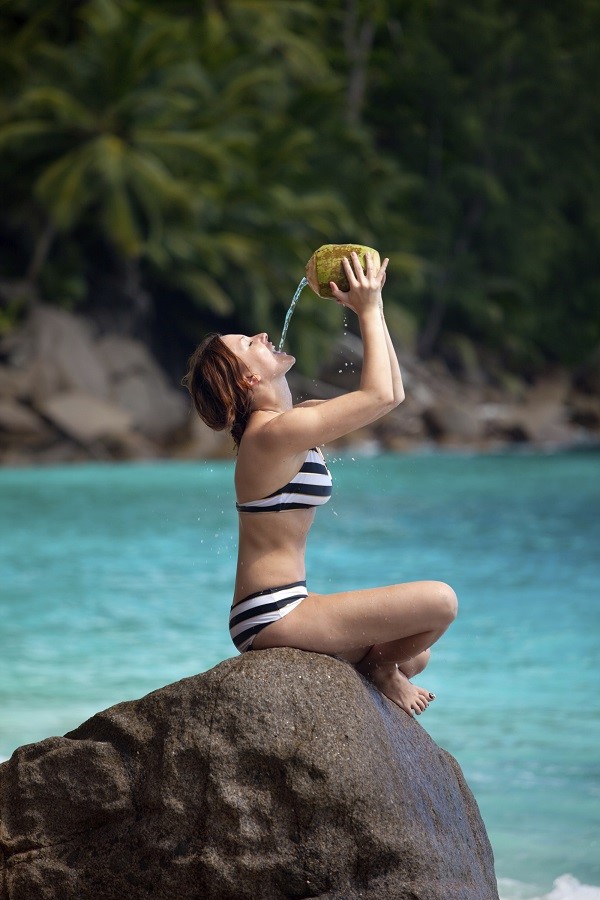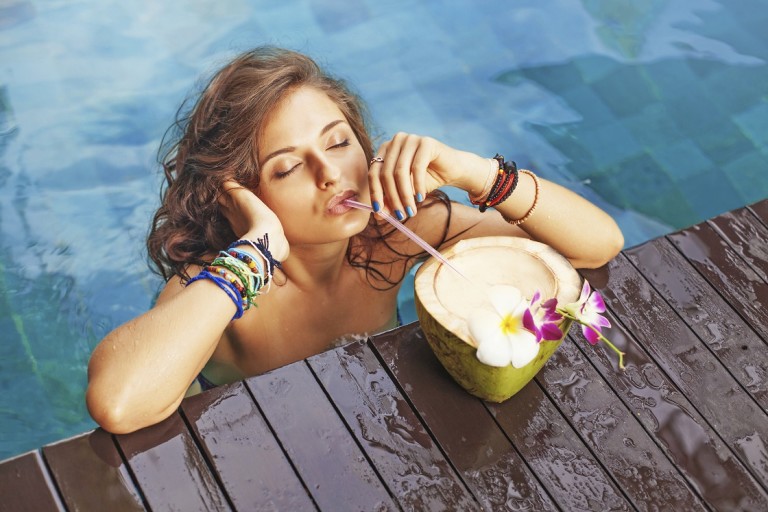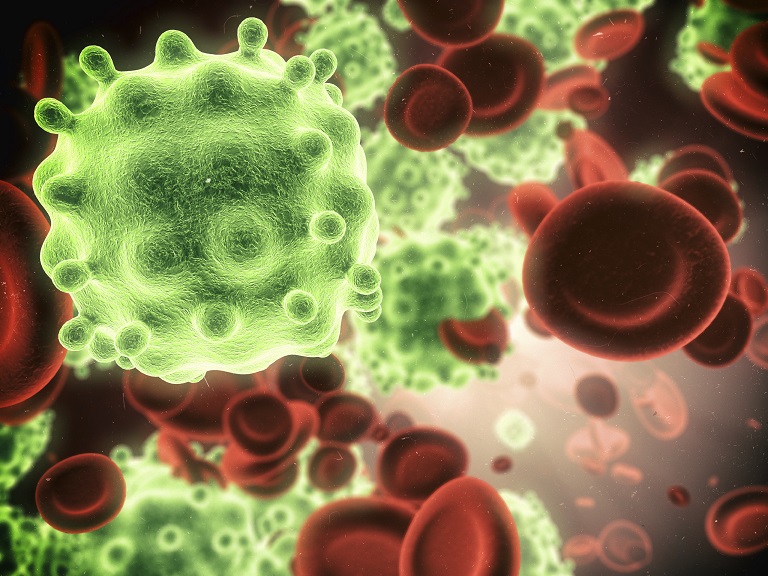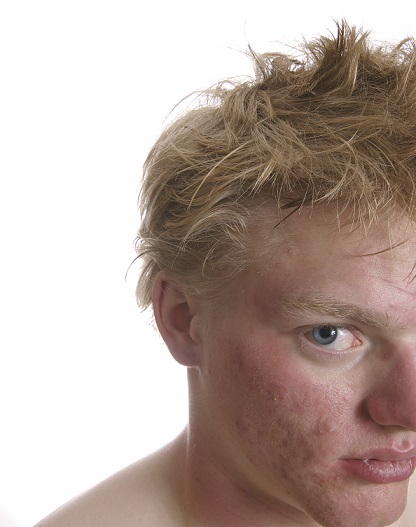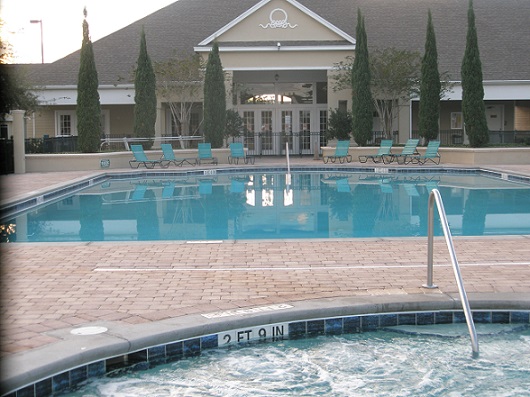 Swimming in a pool is among the most invigorating pastimes known to mankind and spending the day at a waterpark is one of the most enjoyable.
Swimming in a pool is among the most invigorating pastimes known to mankind and spending the day at a waterpark is one of the most enjoyable.
In fact, swimming is astonishingly healthy, because not only is injury almost impossible (unless you foolishly dive into the 1ft deep shallow end), it also works many of your muscles simultaneously. A relentless half hour pool session provides one of the best muscle pumps you can get without visiting a full-blown gym.
However, there’s a problem: the chlorine. You’ll surely know of the stinging eyes and thinning hair. Countless acne patients complain of dry, flaky skin.
Yet somehow, there’s also a vast swathe of acne patients who believe that chlorinated pools improve their acne. The reality is that a dodgy diet is by far the biggest cause, but could chlorine be a secret bonus strategy?
Chlorine – an expert at drying your skin
Firstly, the whole purpose of chlorine, whether in swimming pools or water parks, is to kill harmful bacteria and algae. Without some disinfectant, a swimming pool will become coated with slimy organic matter and bacterial pathogens such as Shigella, e.coli and giardia, leading to the feared “Recreational Waterborne Diseases”. Chlorine has also been used since the early 20th century in US public water supplies (tap water, shower water).
It is these antibacterial powers which have raised the hopes of acne patients everywhere. Their somewhat logical goal is to bathe their skin pores in chlorine and kill the p.acnes bacteria inside, but you definitely should not get tempted into this.
Undoubtedly, some acne patients have seen real improvements after swimming, but consider these factors. Most people swim in outdoor pools during summertime when sunlight is abundant, which increases both acne-clearing vitamin D, and helps to generate an anti-inflammatory gas called nitric oxide. Swimming itself is fantastic, blood-pumping exercise.
Read Annihilate Your Acne – get the greatest diet ever for clear and radiant skin
Furthermore, many people swim most while on a relaxing holiday, where their stress levels are significantly lower, whether due to freedom from their punishing commute, or sheer fun and enjoyment. The “benefits” of chorine may have been confused with something else.
Furthermore, chlorine has strong drying powers which should not be dabbled with lightly.
Just last week, I returned from a holiday in Florida, where every single day I was either swimming in a chlorinated pool or visiting a waterpark. Here’s what I noticed…
ONE – immediately after leaving the chlorinated water, my skin would feel all rubbery and smooth, almost like the skin of an aquatic mammal such as a dolphin, like I had no hair. This effect would persist after having a shower. Initially, my acne was not worse.
TWO – a few hours later, my skin would be extremely dry and flaky. My skin never usually gets flaky.
THREE – by the next day, my skin was still dry and many tiny pimples were beginning to appear, creating a very poor skin tone overall.
This exact story has been replicated hundreds of times on the internet; drying and flakiness is a common theme.
Why does it happen?
This dryness is mainly caused by chlorine damaging proteins on the surface of your skin. These cells then die and slough off, leaving you with a non-hydrated layer of flaky deadness.
Then there’s the skin barrier, your skin’s natural defence system, featuring an acidic PH which destroys infectious viruses and bacteria much like the earth’s atmosphere burning up an entering comet. The skin barrier also controls hydration, even making adjustments in tune with weather conditions like air temperature and humidity.
In this 2003 study, atopic dermatitis patients were exposed directly to chlorine through bathing water. Firstly, the water-holding capacity of the skin fell, or in other words, the skin became drier. Secondly, having atopic dermatitis (an inflammatory skin condition similar to acne) made chlorine’s drying dangers more pronounced.
The loss was dose dependent as well; the more chlorinated the water, the greater the drying effect.
Additionally, the chlorine was only applied for 10 minutes maximum. Therefore, after 40 minutes in a pool or 5-6 hours at a waterpark, the drying will be massively magnified. The bathing water they tested had nearly equal chlorine concentrations to most public swimming pools.
Next: the 6 vitamins and minerals which can massively reduce acne
Unnaturally dry skin might sound cool to many acne patients, but it’s not the godsend it seems. Because hydration is so important for skin barrier function, your sebaceous glands respond by pumping out more oil to compensate.
It doesn’t end there. Apparently, chlorine can penetrate the proteins in your hair shafts and change their colour. Many blonde people have been shocked to observe their hair turning green after a day in the pool.
Can chlorine cause acne from the inside-out?
The human body is obviously more resilient than microscopic bacteria, but it’s still vulnerable. For instance, too much chlorinated swimming is strongly linked to stillbirths and even spontaneous abortion in pregnant women, and congenital malformations in the foetus. A 2007 study found a 35% greater risk of bladder cancer in people drinking chlorinated tap water, while those who regularly swam in chlorinated pools had a 57% greater risk. Increasing cancer is ominous for acne, as it hints at depleted antioxidants and increased free radicals.
Another possible acne danger is damage to your gut flora. All acne patients need a diverse assortment of friendly bacterial strains to prevent leaky gut syndrome, increase nutrient absorption, and protect against inflammatory microorganisms like candida. It’s possible that ingesting chlorine unwittingly could decimate these beneficial colonies. The chlorine might be diluted before it reaches the bacteria, or it may actually kill harmful strains; there are many possibilities.
Contrary to popular belief, you absorb more chlorine while swimming in pools or showering compared to drinking the water.
One University of Pittsburgh study found that skin absorption accounted for 64 percent of waterborne toxin intake, including chlorine. Supposedly, you absorb as much chlorine from a ten minute shower as drinking 8 glasses of chlorinated water!
Human skin has natural barriers against toxins, but chlorine has a molecular weight of just 35.4. Molecular weights of below 3000 can enter human skin, below 750 can enter skin cells, and below 150 can enter the bloodstream.
Next: the 6 vitamins and minerals which can massively reduce acne
In fact, you can prove yourself how well chlorine is absorbed. Visit a swimming pool supply store and purchase a chlorine test kit. Fill a glass with chlorinated water, whether from a swimming pool or tap water. Test it with the kit, and the water will change colour to demonstrate its chlorine level. Stick your finger in the water for 60 seconds, wiggle it, test the water again, and voila – the colour will be completely different, showing a chlorine content of virtually nothing.
Skin absorption is actually worse than drinking chlorine, because there’s no deactivation by digestive enzymes.
Chlorine produces many dangerous by-products
The least famous hazard of chlorine is easily Disinfection By-Products (DBPs), formed when chlorine reacts with organic matter like sweat, dirt, and things I’ll leave you to imagine. Many public pools are teeming with these DBPs; there’s hundreds of different types, depending on the specific organic matter the chlorine reacts with.
One example is cyanogen chloride, a popular chemical warfare agent. One study found that 20% of Americans admit to peeing pools regularly, and CNCI is formed when uric acid reacts with chlorine.
Disturbingly, nearly every chlorinated pool contains CNCI. It’s a known lung and heart toxicant, and can trigger convulsions, coma and death. Fortunately, these higher levels are nearly impossible to reach. If the chlorine was that high in your swimming pool, then you’d be a skeleton by the time you climbed out of it.
Important knowledge – why common vegetable oils are pure evil for acne
Like BPA though, lower levels almost certainly have insidious consequences too, such as inflammation. Another class of DHPs are trihalomethanes (THMs), which particularly accumulate in swimming pools rather than tap water. THMs float above the water, and are breathed in as you swim. Trihalomethanes are a group B carcinogen; cancerous tumours have appeared in limited animal experiments.
Then there’s haloacetic acids, or HAAs, discovered by Spanish scientists in the urine of swimmers just 30 minutes after they left the pool. HAAs are restricted in water supplies due to causing cancer and birth defects. In 49 participants, bodily HAAs persisted for up to 3 hours after a trip to the pool. Some weren’t even swimming; they merely worked by the pool. They were deemed to have inhaled the HAAs in vapour, although swimmers did have levels four times higher. Children also had significantly higher HAA levels after swimming (a child’s skin has a higher absorption capacity).
As for acne? There’s too many DBPs to analyse them all, but CNCI and HAAs are linked to chronic inflammation, while THMs may deplete the all-important antioxidant glutathione.
Interestingly, because these DBPs are formed solely from chlorine reacting with organic matter, every swimming pool on Earth could have a unique profile of them. One pool may have excessive CDCD, another could be full of THMs. This could explain why some people notice more irritated acne from chlorinated pools, whereas others notice nothing.
The strategy
I don’t recommend giving up swimming completely, but there are still plenty of strategies to minimise your risk.
Number one is obvious – if you live by the coast, swim in the sea instead. As long as the water isn’t polluted (or full of sharks), it could benefit your skin, as salt water contains many natural minerals.
Local lakes are another option, if you live rurally (unless it contains brain-eating amoeba), and especially a pristine alpine lake free from pollution. If you live near the Dead Sea of the Middle East, then you have goldmine sitting on your doorstep. The Dead Sea is so rich in minerals that clear skin maniacs flock from all over the world to bathe in its waters.
Secondly, you should get your iodine levels in check. Why? There are 4 natural halides in this world; chlorine, fluoride, bromine, and iodine, the only one which is an essential nutrient (needed for thyroid function).
The other three are toxic, but they’re also lighter than iodine, and easily displace it in the cells. If your iodine levels are low, then chlorine absorption is far greater, because it mistakes the halide structure for iodine.
Vitamin D – the greatest nutrient for a bright and glowing skin tone
Therefore, follow the dietary instructions in this article like eating eggs, seaweed, strawberries, and fish. Alternatively, you could use a highly potent iodine supplement (careful not to take too much) such as Lugol’s Iodine.
Next, always shower immediately after swimming, to remove at least some of the residue. If you have your own pool, then some might recommend saline salt, but this functions by generating chlorine itself. They simply use a machine to create chlorine from the salt through electrolysis. Chemical alternatives are also available, but they’re a complete joke. They’re often more dangerous than chlorine themselves.
Back in the 1950s and 60s, many studies tested iodine; in this one it matched chlorine easily, even outstripping it. It also caused far less stinging and health dangers. However, unless you’re extremely rich, the hassle of devising an iodine based system wouldn’t be worth the small acne advantage, especially if you only swim rarely.
Conclusion
Is chlorine exposure a disaster? No, but it could easily worsen your acne somewhat.
That said, I will never consider giving up swimming in chlorinated pools, and I’ll definitely keep visiting waterparks. The same old theme applies; if you relentless focus on an acne-friendly lifestyle, indulging occasionally will not harm your skin at all. Likewise for eating a healthy diet most days, and a pizza once per fortnight.
Additionally, the damage of DBPs might only be temporary; the Spanish study found that haloacetic acids were fully excreted from the body after just 3 hours.
Don’t worry too much about chlorine. If clear skin means sitting in a room all day staring at the wall, then there’s no point in having it.
NEXT: the ultimate diet for clearing acne permanently
Thanks for reading!

